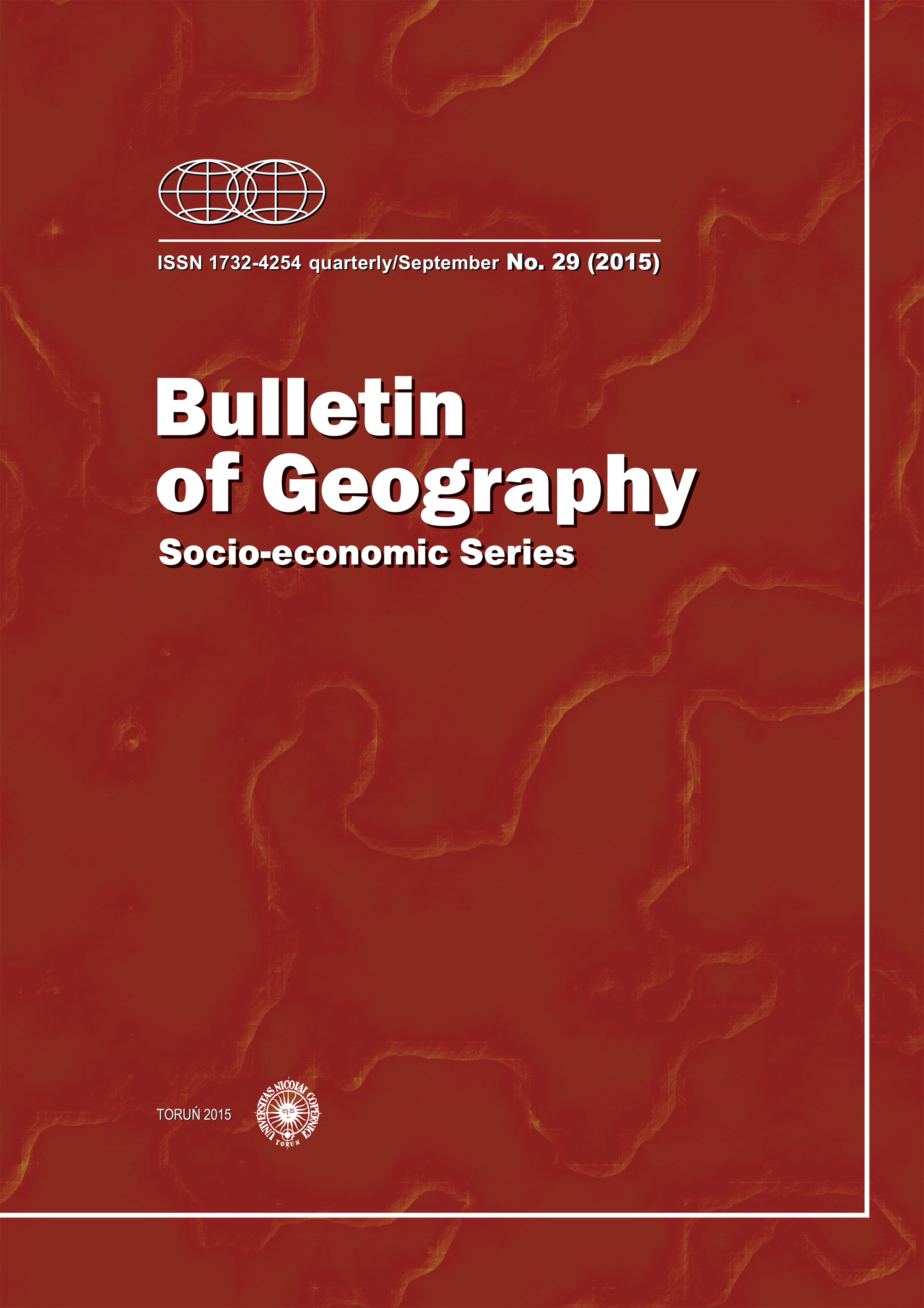Water supply, sanitation and hygiene education in secondary schools in Ibadan, Nigeria
DOI:
https://doi.org/10.1515/bog-2015-0023Abstract
Access to potable water supply, sanitation and hygiene education remains relatively low both in the urban and rural areas in developing countries. The main aim of the study was to get an overview of the condition of the water and sanitary facilities in schools and of hygiene education. The method of investigation involved systematic random sampling with the use of questionnaires and interviews with the students and teachers and onsite inspection of the sanitation facilities available within the schools. The results revealed that 24% of schools used W/C while 76% of schools used pit toilets, of which 88% were ordinary pit toilets and 12% VIP. The number of toilets within the schools ranged between 0 and 14 revealing a 185:1 student to toilet ratio within the study area, but ranged widely from 83:1 to 510:1 between schools. The study, however, revealed the absence of wash hand basins in 77% of the schools and no soap in 88% of the schools with wash hand basins. Investing in clean water, sanitation and hygiene education in these public schools should become a priority for governments in developing countries and School Sanitation and Hygiene Education program (SSHE) should be adopted and implemented across schools in Nigeria.References
Adams, J., Bartram, J., Chartier, Y. and Sims, J. editors, 2009: Water, sanitation and hygiene standards for schools in low-cost settings, Geneva: WHO.
Adukia, A., 2013:Sanitation and Education, Cambridge, MA: Harvard Graduate School of Education.
Almond, D. and Currie, J., 2011: Human capital development before age five. In: Handbook of Labour Economics, Vol. 4(B), pp. 1315-1486.
Amanambu, A.C., and Ojo-Kolawale, O.A., 2013: Geographical Analysis of Eateries in Ibadan North Local Government, Oyo State, Nigeria. In: Brazilian Geographical Journal: Geosciences and Humanities Research Medium, Vol. 4. No. 2, pp. 561-583.
Ana, G.R.E.E., Oloruntoba, E.O., Stridhar, M.K.C. andAdekolu, A., 2008: Water and Sanitation problems in selected schools in Ibadan, Nigeria. In: Proceedings of the 33rd WEDC International Conference: Ghana, Accra: Global Partnerships and Local Actions, p.12.
Birdthistle, I., Dickson, K., Freeman, M., andJavidi, L., 2011: What impact does the provision of separate toilets for girls at schools have on their primary and secondary school enrolment, attendance and completion?: A systematic review of the evidence, London: EPPI-Centre, Social Science Research Unit, Institute of Education, University of London.
Burgers L., 2000: Background and rationale for school sanitation and hygiene education, New York, USA: UNICEF. Available at: http://www.irc.nl/sshe/resources/rationale.htmlDoA: 14 January 2014.
Chetty, R., Friedman, J., Hilger, N., Saez, E., Schanzenbach, D. andYagan, D., 2011: How does your kindergarten classroom affect your earnings? Evidence from Project STAR. In: Quarterly Journal ofEconomics, Vol. 126, No. 4, pp. 1593-1660.
Egbinola, C.N., and Amanambu, C.A.,2013: Climate variation assessment based on rainfall and temperature in Ibadan, South-Western, Nigeria. In: Journal of Environment and Earth Sciences, Vol.3, No.11, pp. 32–45.
Kane, T.J.and Staiger, D.O., 2008: Estimating teacher impacts on student achievement: An experimental evaluation (No. w14607). In: National Bureau of Economic Research,Cambridge: Nber Working Paper Series, pp. 1-38.
Lidonde, R., 2004: Scaling up school sanitation and hygiene promotion and gender concerns. In: School Sanitation and Hygiene Education Symposium. The Way Forward: Construction is Not Enough!In: Proceedings of School Sanitation and Hygiene Education Symposium, the Netherlands, Delft: WEDC, GWA. Available at: http://www.irc.nl/page/13136 DoA: 13 December 2013.
Lopez-Quintero, C., Neumark, Y and Freeman, P., 2009: Hand washing among school children in Bogotá, Colombia.In: Health American Journal of Public Health, Vol. 99, No. 1, pp. 94-101.
National Population Commission (NPC), 2007: Population census and household data survey for Nigeria, Abuja: Federal Government of Nigeria.
Oluwande, P.A., Sridhar, M.K.C and Oyediran, A.B.O., 2008: A manual for hygiene, sanitation and water. In: Publication of Nigeria network for awareness and action for environmental health, Nigeria:Bookbuilders, pp. 1-15.
UNICEF, 1998: A manual on school sanitation and hygiene. In: Water, Environment and Sanitation Technical Guidelines Series.A publication of UNICEF/Programme Division, No. 5, New York. Available at: http://www.unicef.org/wash/files/Sch_e.pdf , DoA: 30 November 2013.
UNICEF, 2004: Life skills-based hygiene education. Available at: http://www.wsp.org/Hygiene-Sanitation-Water-Toolkit/Resources/Readings/life%20skills%20Postma.pdf, DoA: 3 December 2013.
UNICEF, 2013: Gender and water, sanitation and hygiene (WASH): Eastern and Southern Africa. Available at: http://www.unicef.org/esaro/7310_Gender_and_WASH.html, DoA: 12 November 2013.
UNICEF, IRC, 2005: Water, Sanitation and Hygiene Education for Schools. In: Roundtable Proceedings and Framework for Action. Available at: http://esa.un.org/iys/docs/san_lib_docs/SSHE_OxfordRoundTable.pdf, DoA: 30 November 2013.
WFP,2011: WFP’s School Feeding Policy: a Policy Evaluation Vol.II Annexes.: A publication of World food Programme, Rome. Available at: http://home.wfp.org/stellent/groups/public/documents/reports/wfp245403.pdf, DoA: 22 January 2014.
WFP/UNESCO/WHO, 1999: School feeding handbook, Technical Support Service (ODT), Operations Department, WFP: Rome.
WHO, 1997: Primary school physical environment and health. WHO Global School Health Initiative. In: WHO Information Series on School Health, Document Two. Available at: http://whqlibdoc.who.int/hq/1997/WHO_SCHOOL_97.2.pdf, DoA: 31 January 2014.
WHO, 2004: Guidelines for drinking-water quality, 3rd ed. Recommendations, Vol. 1, Geneva: WHO.
WHO/UNICEF/WSSCC, 2004: Global water supply and sanitation assessment 2000 report, Geneva: World Health Organization/United Nations Children’s Fund Water Supply and Sanitation Collaborative Council.
Zomerplaag, J. and Mooijman, A., 2005: Child-friendly hygiene and sanitation facilities in schools: indispensable to effective hygiene education. In: Technical Paper Series, No. 47, New York: IRC International Water and Sanitation Centre, Delft and United Nations Children’s Fund, pp 1-36.
Downloads
Published
How to Cite
Issue
Section
License
Title, logo and layout of journal Bulletin of Geography. Socio-economic Series are reserved trademarks of Bulletin of Geography. Socio-economic Series.Stats
Number of views and downloads: 1829
Number of citations: 7



